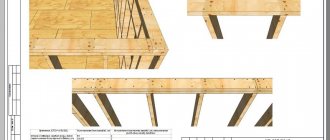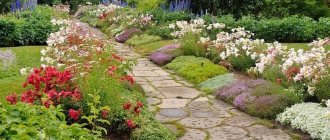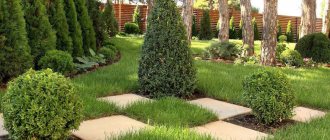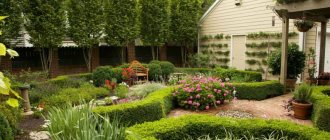Roses look great both in a bouquet and in a summer cottage. The value of these flowers has been great at all times and in all cultures.
This flower delighted the ancient Greeks, Romans, Chinese, and Persians. And in the modern world she continues to be the queen of the bouquet and flower garden. Rose essential oil is widely used in modern cosmetology and perfumery.
However, the main task of the rose remains to decorate the garden. In landscape design, roses act as a central decorative element.
Let's talk about what varieties of roses to choose to set a specific design, and how best to integrate different types of roses into the garden composition.
What makes bush roses different?
- A variety of flower shapes - from classic to terry tea hybrids.
- Long flowering period from May to late autumn.
- Rapid growth - in the summer alone the bush can grow up to 2 m.
- Resistance to temperature changes and ease of maintenance.
- An unusual and strong aroma of flowers.
- Large selection of colors: from cream to lilac and even striped.
- Successful alternation of growth and death of flowers - the bush never ceases to bloom and delight with beauty.
- Shrub roses can be grown even at home in a regular pot.
The choice of one or another variety of roses depends on the goals of landscaping the territory. Many people completely change the position of the bushes and the details of the landscape of their summer cottage every two or three years.
How to choose the right color scheme for a rose garden
When thinking about how best to design a flower bed with roses, you should pay attention to the general style of the area.
For example, calm tones that predominate among flowering plants, a wooden or brick house, naturalness and tranquility will go well with pastel-colored roses. These include tea roses, white and cream, greenish, light purple, soft yellowish, light pink.
Pastel roses go well with bright ones: red, purple, rich yellow, orange. It is better if the pastel is diluted with one or two bright varieties.
If your summer cottage is full of colors, then you can safely combine bright flowers in a pink flowerbed.
The middle option is a combination of two bright colors, for example, red and yellow, white and orange, greenish and purple. Dark and light roses complement each other perfectly.
When planting in a flowerbed, plant 2-4 bushes of the same color next to each other to enhance the effect; single flowers will be “lost” and the flowerbed will look untidy.
Types and varieties of bush roses for the landscape
Rose Marmalade Skies
Wild - bloom once a year with small, neat flowers. They are the easiest to care for - they do not need to be trimmed or shaped at all. They cover fences, the walls of houses, gazebos, and are used as hedges.
Rose Midnight Blue
Climbing - actively used in weaving arches and pergolas.
Rose George Burns
Groundcover - these roses cannot be grown in a pot; they are a bush that crawls along the ground with a carpet of flowers; they also decorate gazebos. The flowers are small, bright with slightly noticeable doubleness. The brightest of this species are roses with the names Hansaland, Elmshorn and Robusta. They are characterized by an early flowering period and are easy to care for.
Rose Elmshorn
Ground cover rose Robusta
Hybrid tea - most often used in bouquets, sometimes as a home bush rose in a pot, they are more delicate than classic types of roses and are perfectly combined in compositions with other flowers that have lush heads, for example, chrysanthemums.
Rose Shooting Star
English - this variety is adored by many gardeners for its ease of care and beauty. From them you can form either a strictly shaped bush - for this you need to cut off the branches heavily - or a spreading, almost mini-tree - then you will hardly need to trim it. Photos of similar landscapes show us garden options from “Alice in Wonderland” to the illusion of a park of kings with wicker arbors. The names of the most popular varieties are Graham Thomas and Abraham Darby.
Pale yellow English rose Graham Thomas
Gorgeous buds of the Abraham Darby variety
Canadian roses are the hardiest roses, able to withstand frosts down to -40°. They are not grown in pots in apartments, but they are simply irreplaceable in gardens in cold regions.
Hot pink Canadian rose
Phloxes
Abundantly blooming phloxes are used as a background for low-growing varieties of roses and as a border for tall ones. When planting seedlings between the bushes, it is important to leave about a meter of free space. Constant air circulation prevents the development of most diseases, rot and fungus.
For the visual appeal of the flower bed, phloxes are chosen in one color. It is better to give preference to white inflorescences with brightly colored roses and vice versa. Excessive diversity will not allow you to enjoy the beauty of any of the cultures.
Rules for planting and care
Any rose garden should be placed in a well-lit place that is not blown by the cold north wind. The soil composition should be rich in humus, and there should be no groundwater near the soil surface. The selected area is cleared of debris, weeds are removed, then the soil is loosened, fertilizer and peat are added and mixed until a homogeneous mass is formed.
To plant roses, dig a hole that is 25-30 cm deeper than the longest root of the bush; it should be about 20-40 cm wide. The roots are lowered into the hole and covered in layers, watering each with water to ensure proper soil shrinkage. The same should be done when planting a bush rose in a pot.
The distance between the bushes should be at least 30 cm, for small varieties 15-20 cm is acceptable, for climbing varieties - 50-100 cm. In the first days, you need to water the soil so that it does not have time to dry out. But this must be done carefully so that the root system does not rot from overwatering; here you need to use moderation. During the growth process, you need to regularly trim the bushes to form the desired shape. In winter, the branches are laid on the ground and covered.
To maintain a constantly blooming garden, many gardeners suggest alternating rose bushes with primroses and other plants that have different flowering periods, for example, chrysanthemums. When mixed, these two aromas create an indescribable combination.
Small flower garden or large
A flowerbed is only part of a flower garden. Therefore, when planning to plant flowers, you need to decide what should happen in the end. This could be a modest flowerbed in which several small rose bushes will grow. Perhaps in proximity to other plants that are not dangerous to roses.
Or it will be a flower garden of various types of roses, complemented by other plants. The golden mean is quite possible, but the planning begins with the design of the planting scheme.
If space allows and there is a desire to plant different varieties of roses on the site, then you need to think through a plan so that tall bushes do not shade or hide short-growing neighbors.
And climbing plants must receive the support they need. If we are talking about flower beds, then you should pay attention to varieties that are suitable specifically for this purpose.
In large flower beds you can combine roses. For example, tall bushes are in the center, and as you approach the edges, the growth of the bushes decreases.
In addition, you need to think about planting so that the roses bloom, replacing each other. This way the flowerbed will look elegant for a long time.
Among other things, we must not forget that in winter, rose bushes need to be covered to protect them from frost. Therefore, when planning a large flower garden, you need to think about this point in advance.
Shrub roses and landscape options
When planting bush varieties for the first time, you should not immediately take on weaving arbors or building hedges; you should learn from simpler things.
Simple ways to revitalize an area with live roses:
Flower beds - bush roses are placed around the site in beautiful, specially prepared places.
Borders are bushes, the easiest to care for, planted around the perimeter. In some cases, this is simply a living frame for the path, in others, grooves are formed for them from brick and stone, or twisted decorative fences are installed in front of the bush line.
Group – a territory is selected on which only the rose garden will be located. The bushes can be arranged by variety or color - you will get a cozy corner for relaxation in the Provence style, where you can put ordinary plastic chairs, a table with an openwork tablecloth and a white garden umbrella.
If the roses take root well, you can safely take on and form hedges, large arches, and weave them around walls and gazebos.
Delphinium
Delphinium inflorescences pointing upward are an excellent backdrop for a rose garden. The flowerbed can be made multi-colored or monochrome, consisting of two types or including dozens more plants.
It is not recommended to plant a rose close to a delphinium. The latter is distinguished by a well-branched rhizome that can inhibit surrounding plants.
Arches and secrets: romantic garden design
Arches can be different - their choice is dictated by the style of the site; they are not always just oblong arches. Arches can be low, high, round, square. The shape is selected in accordance with the general concept of the landscape.
How to choose:
- you have to start with the size. If it is just a decorative element, the arch may be small, but if people will pass through the structure, the appropriate width and height must be taken into account;
- correlate the general style and geometry. If smooth lines predominate in the garden, it would be inappropriate to install asymmetrical corner arches, as well as any rectangular lines with too clear sharp outlines. Similar elements are appropriate in modern styles;
- choice of material. The most common choices are metal or wood. Metal arches are more practical and interesting in design - they can be not just cast arches, but forged, with many monograms and carved elements. Unlike their wooden counterparts, they will not stain, become wet or dry out. In addition, they are much easier to install in the ground and have better stability. Due to their versatility, they are suitable for all styles, while wooden arches are appropriate in country, Provence, and rustic styles. They do not fit very well into modern landscape variations.
Many landscape designers and simply creative people like to create a kind of “through the looking glass” effect - installing cascades of arches entwined with climbing roses. Someone even puts mirrors, and it turns out to be a real portal through which you can easily get into Lewis Carroll’s books or visit Exupery’s “The Little Prince”.
Shrub roses are a dream for a novice gardener and landscape designer of any level. These are extremely low-maintenance and very beautiful plants, which in the skillful hands of a decorator can turn reality into an extraordinary fairy tale. But if you don’t have a garden, don’t be upset either, because you can always grow a bush rose at home, and then this fragile beauty will delight you constantly.
Lavender
Lavender is an excellent protector against aphids and ants. With proper care, cultures form an incredibly beautiful duet. Lilac-pink flower beds decorate the garden paths, front entrance and seating areas.
For greater decorativeness, lavender is planted in groups, which during flowering creates the effect of a lush cloud. Both plants love the sun, so you should not place them too close to each other. Tall varieties of roses are tied to a support, providing light access to the soil around the bush.
Vertical gardening
Decorating gazebos, terraces, arches, and facades in a vertical plane is an excellent solution not only aesthetically, but also protection from dust, noise, wind and summer heat. Climbing roses with medium and small flowers are suitable for this.
In combination with clematis and virgin grapes, they will create unique beauty and give an unforgettable experience.
Parsley
In addition to ornamental crops, rose bushes get along well in the same bed with fragrant parsley, oregano and thyme. The latter, with their aroma, repel pests from flower beds, ensuring calm flowering throughout the summer. A lush carpet of small-leafed greenery prevents weeds from settling in the flowerbed, and a plain background favorably emphasizes the beauty of the inflorescences.
When selecting neighbors, it is important to pay attention not only to the visual compatibility of colors, but also to their requirements for soil quality. There should be enough nutrition, light and moisture for both crops.











